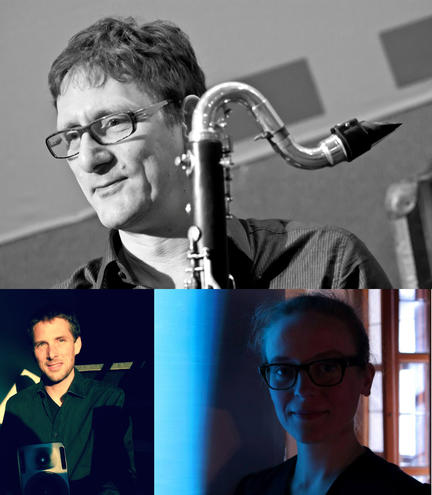No longer uptodate!
After nearly 15 years, this website is being decommissioned. For a while, this old version will still be reachable, but it will no longer show reliable information about events at ausland,
The new version of our website can be found here: https://ausland.berlin
Frank Gratkowski + Strassmüller/Mayer-Lindenberg

Frank Gratkowski – composition, alto saxophone, live electronics
Articulations E for Alto Saxophone with Live Electronics
Matthias Strassmüller – composition, electronics, guitar
Annegret Mayer-Lindenberg – viola
Zirkel (guitar & live-electronics)
Impromptu (version for viola & electroacoustic sounds)
Doppelbewegung (viola & live-electronics)
Ensembles (guitar & electroacoustic sounds)
Source (viola & live-electronics with electroacoustic sounds)
Frank Gratkowski: Artikulationen E
Having worked for several years with my own programs deigned as compostion aids, I wanted to deepen my research in the field of live electronics. This began with a 6 week residency in 2010 at the CNMAT in Berkeley California, which was made possible by a grant from the Goethe Institute. A further residency followed in 2011. During the residency I developed and built a controller for the saxophone which can be controlled during playing and made to program the new “instrument” with MaxMsp. The player moves freely in the space. Attached to the instrument is a specially designed controller over which the player can control the live electronics. There are no pre-recorded sounds – all of the sound material is generated by the live saxophone and clarinet and projected through 8 loud speakers.
Nachdem ich über viele Jahre selbstgeschriebene Programme als Kompositionshilfen benutzt habe, habe ich angefangen mich intensiv mit dem Thema Live-Elektronik auseinander zu setzten. Der Beginn war ein 6wöchiger Aufenthalt am CNMAT in Berkeley, Kalifornien, USA, mit Hilfe eines Stipendiums vom Goethe-Institut in 2010. Ein weiterer Aufenthalt folgte in 2011. Dort habe ich Controller für Saxophon entwickelt und gebaut, welche sich während des Spielens bedienen lassen, sowie das „Instrument“ mit MaxMSP programmiert.
Der Spieler bewegt sich frei im Raum. Am Instrument ist ein eigens zu diesem Zweck entwickelter Controller angebracht, über den der Spieler die Live Elektronik kontrollieren kann. Es gibt keine vorher eingespielten Klänge, die Elektronik wird ausschließlich aus live gespieltem Altsaxophon und Bassklarinette generiert und über 8 Lautsprecher in den Raum projiziert.
Annegret Mayer-Lindenberg / Matthias Strassmüller
Mayer-Lindenberg/Strassmüller perform five pieces for instrument and electronics, four of which are based on the same software-implementation developed in Max by Matthias Strassmüller. The software-implementation enables instrument/electronics relationships ranging from an immediate interlocking of acoustic and electronic sound to soundscapes more remote from the original material. It makes use of controlled random-operations to steer durations, pitch, volume envelope, frequency of occurrence, spatial placement and temporal displacement of the live-sampled sounds. The pieces scrutinise the domain between a variety of instrument/electronics relationships: how are transitions designed between the above mentioned extremes, by means of seamless shifts, gradual development, contrapuntal opposition? What musical languages evolve from the different instrument/electronics relationships? Annegret Mayer-Lindenberg’s expertise in extended playing-techniques and her focus on the timbral qualities of the viola serves as a basis for the sonic material of the viola pieces.
Mayer-Lindenberg/Strassmüller bringen fünf Stücke zur Aufführung, von denen vier dieselbe von Matthias Strassmüller in Max entwickelte Software-Implementierung verwenden. Diese ermöglicht eine Bandbreite von Instrument/Elektronik-Beziehungen – vom direkten Ineinandergreifen des akustischen und elektronischen Klangs hin zu unabhängigen Klanglandschaften des verfremdet elektronischen Materials. Die Software bedient sich dabei der Wiedergabe von live-Samples deren Länge, Tonhöhe, zeitlicher Abstand vom live-Sound, Häufigkeit, Hüllkurve und räumliche Platzierung durch kontrollierte Zufallsoperationen gesteuert wird. Die Stücke loten das Spannungsfeld zwischen verschiedenen Instrument/Elektronik Beziehungen aus: wie gestalten sich Übergänge zwischen den oben beschriebenen Extremen, durch fließende Nahtlosigkeit, graduelle Entwicklung, kontrapunktische Gegensätzlichkeit? Welche musikalischen Sprachen lassen sich aus den verschiedenen Instrument/Elektronik Beziehungen ableiten? Annegret Mayer-Lindenbergs Expertise hinsichtlich erweiterter Spielweisen und Klangfarbenrepertoire dienen als Ausgangspunkt des Klangmaterials der Bratschenstücke.
Kindly supported by Konzert des Deutschen Musikrates
Doors: 8.30 pm
Concert start: 9.00 pm


